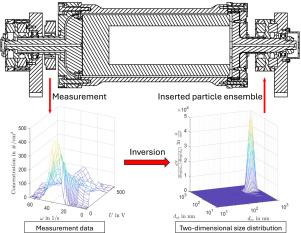pocs算法-一种通过示例性CDMA测量数据的数据反演计算二维粒子特性分布的有效工具
IF 2.9
3区 环境科学与生态学
Q2 ENGINEERING, CHEMICAL
引用次数: 0
摘要
在许多情况下,颗粒表征不是微不足道的,因此需要数据反演例程,以便从测量数据确定粒度分布。特别是,粒子二维性质分布的确定对分析复杂形状粒子非常有价值,但会导致大型病态方程组的求解,这是具有挑战性的。本文首次将凸集投影(POCS)方法应用于粒子表征中此类问题的求解。POCS方法是一种迭代算法,它允许使用关于分布的所有可用信息来显著减少潜在解的数量。本文以离心式差分迁移率分析仪(CDMA)为例,展示了该方法的应用,该分析仪在不同电压和角速度(即受控的电和离心力)的组合作用下,测量了在两个同心圆柱体之间的间隙中分类后的纳米级气溶胶的数量浓度。详细描述了POCS算法在这个问题上的应用,包括适当的边界条件和投影算子的公式,以包括所有可用的信息。进一步,对算法的实现进行了说明。然后利用该算法对构造的理想数据和带叠加噪声的构造数据进行反演。实验结果表明,在这两种情况下,POCS算法都能获得稳定有效的测量数据反演,并能获得高精度的关于迁移当量直径和斯托克斯直径的二维粒子性质分布。最后,将该算法应用于从新器件原型获得的实际测量数据,以获得真实的二维密度分布。本文章由计算机程序翻译,如有差异,请以英文原文为准。

The POCS-Algorithm—An effective tool for calculating 2D particle property distributions via data inversion of exemplary CDMA measurement data
In many cases particle characterization is not trivial, so that data inversion routines are needed in order to determine particle size distributions from measurement data. In particular, determination of two-dimensional particle property distributions, which are very valuable for analyzing complex shaped particles, results in large ill-posed systems of equations which are challenging to be solved. In this paper the Projections onto Convex Sets (POCS) method is implemented for solving such problems in particle characterization for the first time. The POCS method is an iterative algorithm which allows the use of all available information about the distribution to significantly reduce the number of potential solutions. Here, the application of this method is shown for the example of a Centrifugal Differential Mobility Analyzer (CDMA), which measures the number concentration of a nanoscaled aerosol after classification in a gap between two concentric cylinders with a combination of different voltages and angular speeds, i.e. controlled electrical and centrifugal forces. The application of the POCS algorithm to this problem comprising the formulation of appropriate boundary conditions and projection operators to include all available information, is described in detail. Further on, the implementation of the algorithm is explained. The algorithm is then used to invert constructed ideal data and constructed data with superimposed noise. It is demonstrated that the POCS algorithm in either case is well suited to obtain a stable and efficient inversion of the measurement data and to obtain highly accurate 2-dimensional particle property distributions with respect to mobility equivalent diameter and Stokes diameter, respectively. Finally, the algorithm is applied to real measurement data obtained from a prototype of the new device to derive real 2D density distributions.
求助全文
通过发布文献求助,成功后即可免费获取论文全文。
去求助
来源期刊

Journal of Aerosol Science
环境科学-工程:化工
CiteScore
8.80
自引率
8.90%
发文量
127
审稿时长
35 days
期刊介绍:
Founded in 1970, the Journal of Aerosol Science considers itself the prime vehicle for the publication of original work as well as reviews related to fundamental and applied aerosol research, as well as aerosol instrumentation. Its content is directed at scientists working in engineering disciplines, as well as physics, chemistry, and environmental sciences.
The editors welcome submissions of papers describing recent experimental, numerical, and theoretical research related to the following topics:
1. Fundamental Aerosol Science.
2. Applied Aerosol Science.
3. Instrumentation & Measurement Methods.
 求助内容:
求助内容: 应助结果提醒方式:
应助结果提醒方式:


